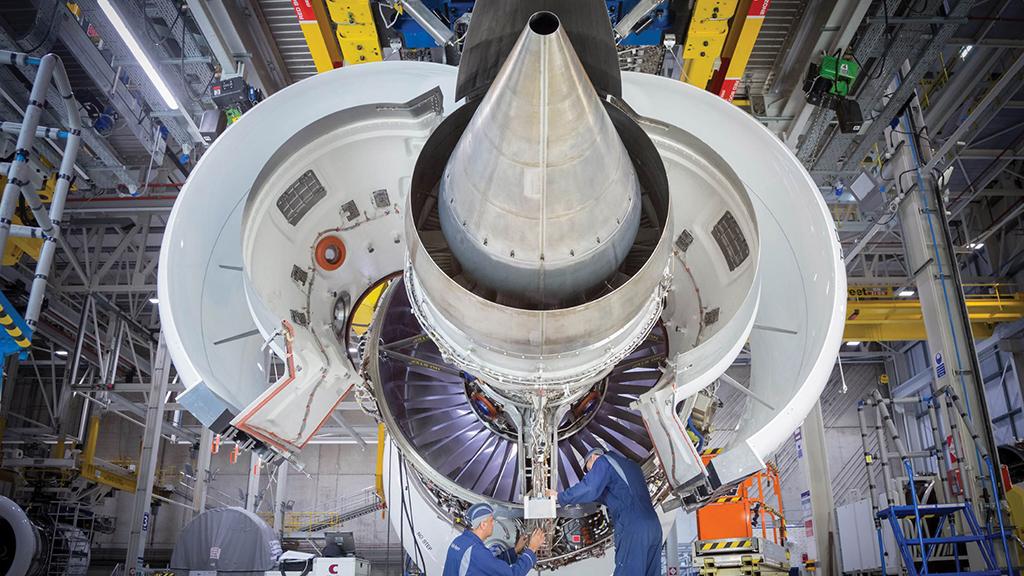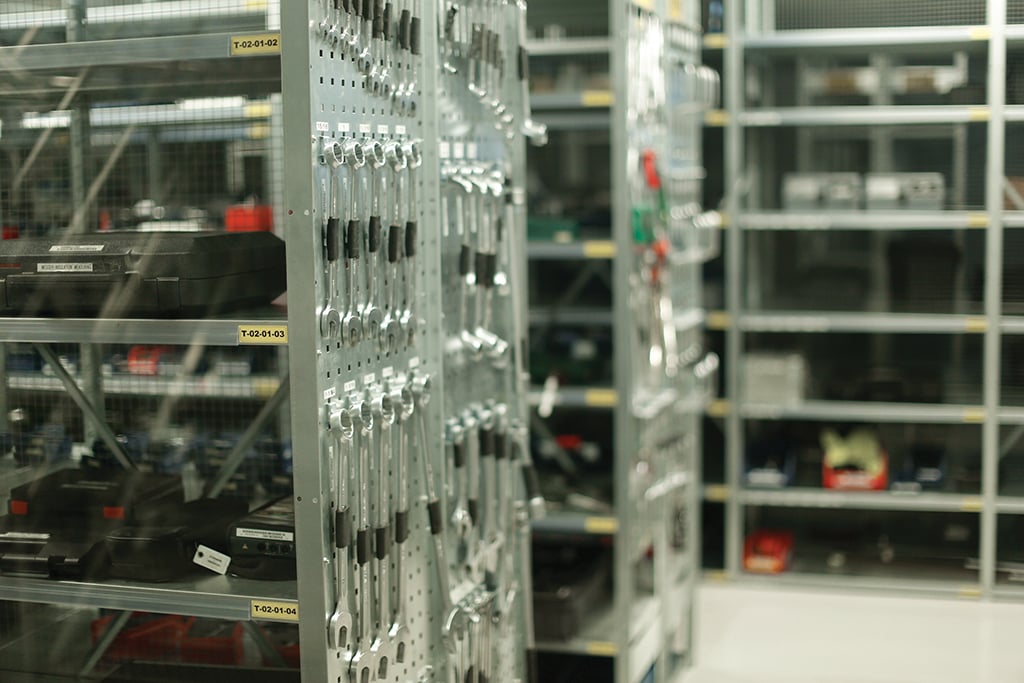
New engine and airframe programs are leading to greater demand from tooling specialists.
As market demand for MRO services ramps up, the commercial aftermarket is contending with major challenges in its supply chain. Workforce shortages, capacity constraints and parts and material availability have all affected operations as demand outstrips supply. This scenario also has seeped into the availability of tooling for both airframe and engine maintenance.
The tooling in question mostly has centered on newer programs growing in scope and demanding more technologically complex tooling than those with more mature aircraft and engines. In recent years, industry sources have noted tooling shortages related to airframe and engine programs such as Airbus A320neo, Boeing 737 MAX and Rolls-Royce Trent engines. Further shortages in certain parts of the market are anticipated. Aviation Week reported late last year on a looming shortage of Pratt & Whitney PW1100G and PW1500G engine stands and ground support equipment (GSE) as the manufacturer grounds hundreds of engines through 2025 to implement durability fixes.
“Newer engine technologies are very sophisticated, and the number of unique products that are required around tools and support equipment to truly do all the MRO activity is quite extensive,” says Anthony Turner, chief commercial officer at Rhinestahl, a U.S.-based supplier of tooling solutions for MRO shops with CFM, GE and Rolls-Royce engine repair capabilities, in addition to GSE and engine stands. “The product catalogs to support these engines number in excess of 2,000 unique tools to assemble, disassemble, repair and maintain an engine, and the scale of that can be overwhelming for some MRO providers.”
Turner says tooling procurement tends to be low on the value chain for some MRO specialists for several reasons. “It’s often one of the last things organizations plan for because it’s an indirect product that tends to be a one-time buy,” he notes. “They often don’t have a robust planning cycle around this product category and capability.” He adds that Rhine-stahl has positioned itself as a “system integrator” rather than just a tooling supplier by being proactive in advising customers on their required inventory levels over set periods, depending on the needs of their facility.

Reflecting the surge in MRO demand over the past 18 months, Rhine-stahl says it saw demand for tooling return to pre-pandemic levels in 2023 following a sharp decline in 2020-21 as airlines with grounded fleets had cut back on maintenance costs to preserve cash flow. Turner says demand has since exceeded pre-pandemic levels and the company’s expectations.
In the narrowbody segment, Turner identifies the CFM Leap engine family as a particular growth area. CFM is ramping up development of the Leap-family aftermarket network as the engine’s orderbooks and production backlogs continue to grow.
However, tooling in the widebody segment is recovering more slowly, he says. “Widebodies are a little bit of a different market, and there has been a bit of a lag,” Turner explains. “Especially in Asia-Pacific and some of the other markets where the reopening of those economies was a little bit slower in recovery. The amount of activity in widebodies was more moderate. However, this is starting to come to life, especially in other regions away from the Americas.”
While Rhinestahl has experienced challenges like the rest of the industry, Turner credits its tightly integrated partnerships with the major engine OEMs as a primary reason for its relatively smooth supply chain and high delivery rates. “We’re able to help them manage that demand and supply pretty easily and have enough advanced notice to take care of whenever additional equipment is needed by the OEM,” he says.
Alan Oak, Rhinestahl’s chief operating officer, says the company has sought to increase capacity to meet growing market demand, but this comes with challenges. “One route is the traditional ‘let’s go out and find and develop new suppliers,’ although in the tooling industry, that’s not really easy because it’s a very niche market from a supply chain standpoint,” he says. From a supplier perspective, he believes more MRO providers are open to exclusivity with one tooling provider to manage their shop requirements.
Adding the perspective of a maintenance provider, Frederic Pralus, CEO of Cyprus-based Bird Aviation, says tooling shortages vary depending on factors such as market demand, technological advancements and supplier capabilities. Tooling shortages “reflect a combination of factors including increased demand for MRO services due to growing fleets, technological advancements leading to the need for more specialized tools, disruptions in the global supply chain due to events like the COVID-19 pandemic and potential shifts in manufacturing practices,” he says.
“Compared to a few years ago, there might be a higher level of complexity in tooling requirements and a greater reliance on global supply chains, which can exacerbate shortages during periods of disruption,” Pralus adds.
“Developing new capabilities requires the MRO to invest in new tools and then clearly depend on a constrained supply chain to deliver approved and certified products in a reasonable lead time and at affordable prices,” he explains. “This is currently the case, for example, for the new generation of aircraft like the A320neo and their new type of engines.”
The problem is further compounded by increasingly strict certification measures imposed by OEMs, Pralus says. “This is to face the proliferation of ‘tools suppliers’ on whom they don’t have control and who potentially increase the risk of maintenance incidents due to poor quality,” he says.
Pralus says he has encountered shortages of engine maintenance tools such as borescopes, fan blade inspection equipment and engine disassembly tools. “Additionally, precision measurement tools and composite repair kits are also in demand and may face shortages,” he notes.
Increased demand is sharpening the impact of tooling scarcity for other MRO providers, too. “The shortages are strongly felt for the A320 airframe and Leap 1 engine tooling,” says Maksim Kolesnik, head of facilities and tooling at Estonian maintenance specialist Magnetic Group. Kolesnik says he sees no major differences between the purchasing of narrowbody and wide-body tooling when working with established suppliers but cites specific tools as particularly challenging to acquire. “Starting from ATA 27 [flight controls] up to ATA 71 [powerplant], the availability [has declined] of special testers such as air data test sets, videoscopes and nondestructive testing equipment, which are all crucial in the aviation market,” he says.
Before the COVID-19 pandemic, the aviation industry benefited from a broader array of suppliers offering aircraft specialist tools for narrowbody aircraft with more favorable delivery times, typically ranging from 1-2 weeks, Kolesnik states. “Moreover, there was reliable availability directly from warehouses, and notably, production standards often yielded higher-quality tools,” he adds.
The current landscape presents challenges, Kolesnik says. “The quality of tools and engineering solutions procured today occasionally falls short, necessitating additional in-house supplementation,” he explains. As in the parts market currently, tooling supply is not immune to price fluctuations. “Price discussions often seem futile, as markups sometimes reach as high as 100%,” Kolesnik states.
Magnetic Group says as of February, it is experiencing average delivery times of 5-9 weeks for tooling. This can be problematic when it affects certain maintenance tasks at its facility in Tallinn, Estonia. “Procuring reserve quantities within a 5-9-week time frame may not adequately support heavy maintenance checks, which typically last four weeks,” he says. “It is imperative to demonstrate that effective planning and access to equipment from the loan market have prevented an impact on maintenance work.”
Pralus says Bird Aviation also must wait “several weeks to several months” for tooling, depending on the specific item. “Lead times for obtaining specialized tools can vary significantly depending on factors such as supplier availability, production capacity and shipping logistics,” he says. “Longer lead times can disrupt maintenance schedules, increase aircraft downtime and potentially lead to delays in returning aircraft to service. This can have cascading effects on airline operations and maintenance providers’ revenue streams.”
Going forward, providers are looking at sophisticated methods of procuring tooling in required volumes to avert crises. Magnetic Group says for its Engine-Stands24 business, which leases and sells engine stands for the CFM International CFM56, Leap 1A and 1B; General Electric CF6 and CF34; and International Aero Engines V2500, it has begun advanced planning and forecasting along with meeting changing supply by expanding its engine stands pool.
“Our approach has been to purchase additional maintenance tools in advance to serve as backup and ensure a reliable source of equipment for loan purposes,” Kolesnik says. This strategy has been adopted by the wider industry, with more MRO providers commonly stocking higher volumes of tooling, reflecting the trends to house more component inventory.
Meanwhile, Pralus says Bird Aviation has implemented several strategies to overcome or mitigate tooling shortages and supply chain issues. “This includes diversifying the supplier base to reduce reliance on a single source, establishing strategic partnerships with tooling manufacturers to secure priority access to critical tools, investing in in-house tooling-approved capabilities for manufacturing or refurbishing essential tools and optimizing inventory management practices to ensure adequate stock levels of essential tools,” he says.





